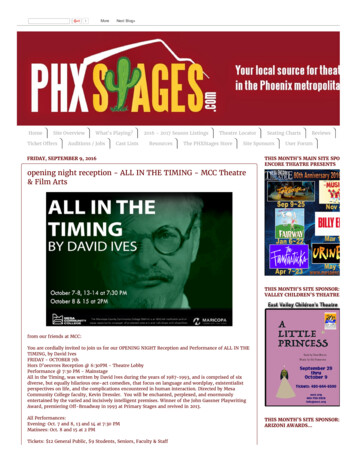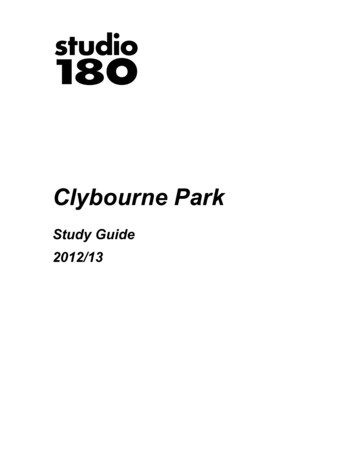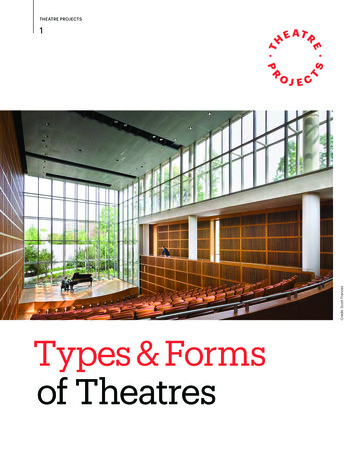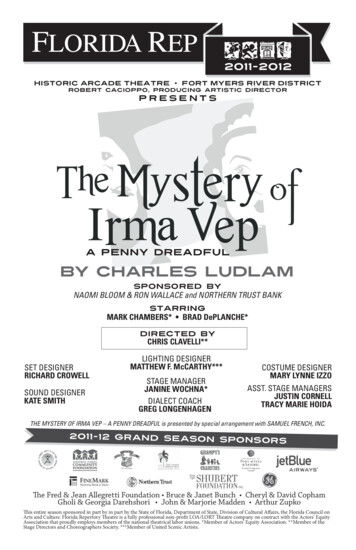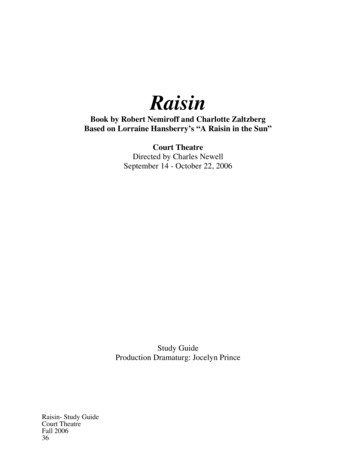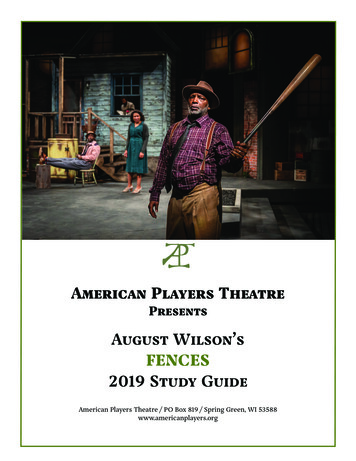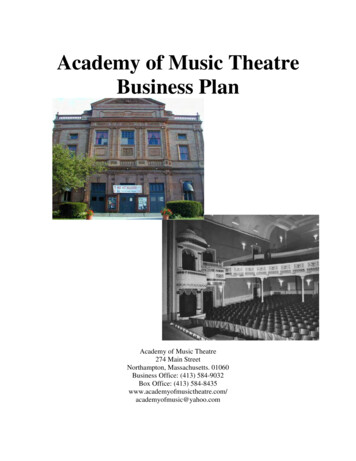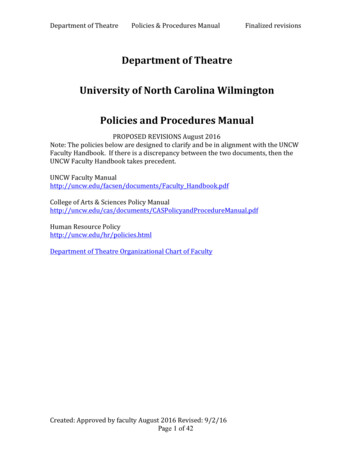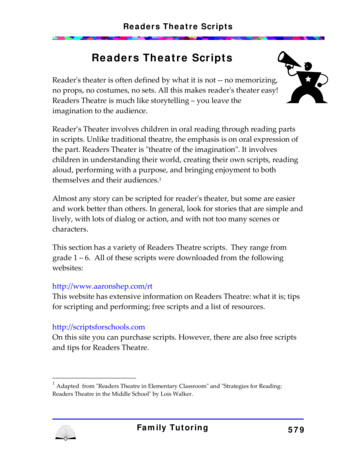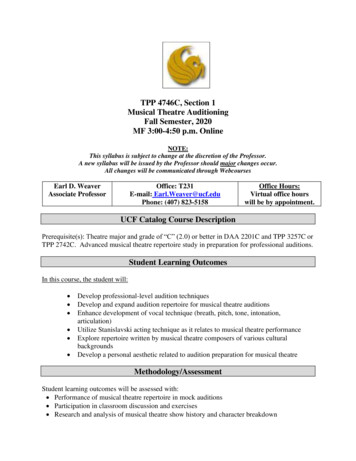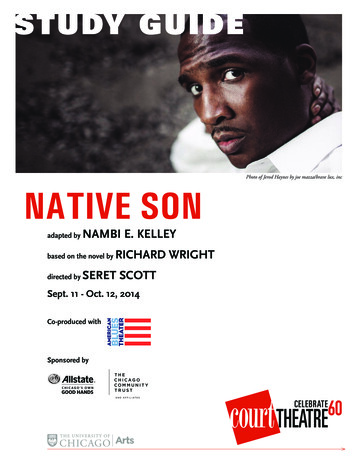
Transcription
STUDY GUIDEPhoto of Jerod Haynes by joe mazza/brave lux, incNATIVE SONadapted byNAMBI E. KELLEYbased on the novel bydirected byRICHARD WRIGHTSERET SCOTTSept. 11 - Oct. 12, 2014Co-produced withSponsored by
Native Sonadapted by Nambi E. Kelleybased on the novel by Richard WrightSETTINGTwo cold and snowy winter days in December 1939Chicago’s Blackbelt and surrounding areasCHARACTERSBiggerA 20 year old, African-American male from the South Side ofChicago. He has dreams of being a pilot but struggles with makingthat dream a reality as a result of his environment, race and economiccircumstances.The Black RatHe is the visible representation of Bigger’s inner thoughts.MaryThe rebellious, White daughter of Mr. and Mrs. Dalton. She desiresto befriend Bigger while also maintaining her power and privilegeover him.JanMary’s boyfriend, involved with the Communist Party.HannahBigger’s mother. Lost her husband, Bigger’s father, in a riot and nowstruggles to care and provide for Bigger and his siblings.BuddyBigger’s younger brother. He looks up to Bigger and, resultantly,often helps Bigger with his schemes.BessieBigger’s girlfriend, a maid, who attempts to help Bigger while he ison the run from the police.Mr. DaltonOwner of the South Side Realty Company. He owns the apartmentswhere Bigger and his family lives. Bigger eventually becomes thechauffer for Mr. Dalton’s household.Mrs. DaltonThe blind wife of Mr. Dalton and Mary’s mother.BrittenThe private investigator the Dalton’s hire to find Mary.VeraBigger’s younger sister.GusBigger’s friend. They have an antagonistic relationship with eachother, at times, since Gus unconsciously makes Bigger aware of hisinsecurities and fears.Costume rendering by Melissa Torchia.2
SYNOPSISBigger Thomas has dreams. Dreams of being a pilot and ofbeing something more than what his circumstances as a young,Black man living on the South Side of Chicago in the late1930s would allow. In order to help his struggling mother andsiblings, he accepts a chauffer job in the home of a wealthy,White family in the Hyde Park area of Chicago. Bigger’s dreamsare suddenly cut short when he accidentally kills the daughterof the family and must go on the run from the police. Thisadaptation, based on the classic novel, Native Son, by RichardWright, tracks the societal circumstances that led to Bigger’sfateful killing of Mary Dalton and his attempts to evadecapture by the police.THEMES1. Fate vs. Free Will: debating whether or not Bigger was avictim of fate or his own free will is a major discussion/debate in both the novel and this adaptation.2. Race and class: Native Son chronicles the distinct racialand class divides between Blacks and Whites in Chicagoduring the 1930s and the effect that has on each group’sunderstanding and compassion for one another.3. Religion: Bigger finds himself at odds with the religion hegrew up with as he attempts to reconcile his actions and hisfate.4. Fear: this adaptation illustrates how fear became the mainemotion behind Bigger’s actions.5. Power/lessness: The adaptation also focuses on power andprivilege and how one person’s power can bring to lightanother person’s powerlessness.6. Double-consciousness: an idea that comes fromW.E.B. Du Bois in his book, The Souls of Black Folk,that explains how people of color often have to learn tonavigate their own culture while also learning to navigatethe institutionalized systems of dominant culture. Theplaywright of this adaptation adds a character into the play,the Black Rat, who speaks the inner thoughts of Bigger,which are often very different than the ones he speaks. TheBlack Ray symbolizes, in many ways, this idea of doubleconsciousness.Photo of Jerod Haynes by joe mazza/brave lux, inc3
RICHARD WRIGHT AND THE NOVEL NATIVE SONThis play is an adaptation, written by Nambi E. Kelley, of thenovel, Native Son, by Richard Wright. Richard Wright (19081960) is the literary icon behind the novel Native Son. Bornin Mississippi, his travels and experiences heavily influencedhis writings. For example, Wright knew of life in Chicago(as seen in Native Son) through the first hand knowledge hegained when he moved to Chicago in 1927, where he workedas a postal clerk until he was laid off from his job and had touse relief (public assistance) in order to survive. Also, whilein Chicago, he made contacts with the Communist Party viahis extracurricular activities and eventually joined the party in1933. Therefore, the representation of the Communist Party(as found in Native Son), and the way mainstream societyviewed it, stems from that point in his life. As a result, thesuccess of his writings changed the way in which societyat-large understood race, class and the politics of AfricanAmericans.Native Son, written in 1940, tells the story of Bigger Thomas,a 20-year-old living in Chicago’s South Side in the 1930s. Atome comprising of three “books,” it paints a bleak picture ofthe present and future of Bigger by illustrating the systematicforces that oppress young, African American males in theUnited States. Wright, with this book, points a finger at howAfrican Americans’ oppression in the U.S., by the hands ofthe racial majority (in terms of politics and economic power),contributes to the self-destructive motivations and behaviorsof African Americans.Critics met the book with praise and condemnation. Somelauded its naturalism and blatant discussion of the racialdivide in America, while others chastised its use of violenceand its narrow focus on the African American experience.4Photo of Richard Wright.
PLOT OF THE ADAPTATION OF NATIVE SONAND NON-LINEAR STORYTELLINGThe plot of this adaptation of the novel mainly focuses on thefirst two books of the novel Native Son: “Fear” and “Flight,”although it does incorporate some aspects of the third book,“Fate.” In addition, this adaptation is told in a non-linearmanner. This means that although the story the play tellsoccurred linearly, the plot (the manner in which the playwrightchooses to reveal the story) is not. The play takes place, mostly,in the head of Bigger Thomas. At the top of the play, Biggerfinds himself remembering and reliving the series of events thatlead to his not-in-his-head capture by the police. Starting withthe murder of Mary Dalton, we see Bigger move backwardand forward in time as events such as the loss of his father atyoung age, his beating by the police when they come to forciblymove his family out of their apartment, his broken dreams ashe resigns himself to being the breadwinner for his mother andsiblings, the job he must take in a wealthy family’s home, andan introduction to Mary and her communist boyfriend, Jan, allcome together to create the perfect storm that leads to Biggercommitting a murder.DOUBLE-CONSCIOUSNESSThe term originated from an Atlantic Monthly article of DuBois’s titled “Strivings of the Negro People.” It was laterrepublished and slightly edited under the title “Of OurSpiritual Strivings” in his book, The Souls of Black Folk. Du Boisdescribes double consciousness as follows:ABOUT THE PLAYWRIGHTNambi E. Kelley is the adaptor for this version ofthis classic novel. Kelley has penned plays for theSteppenwolf Theatre and the Goodman Theatrein Chicago, and the Lincoln Center in New York.Also an actress, Nambi has worked on stage andtelevision in Chicago, New York, Los Angeles, andinternationally, playing opposite such artists asPhylicia Rashad, Alfre Woodard, Blair Underwood,and Patrick Swayze. Ms. Kelley has a BFA fromThe Theatre School at De Paul University, formerlyknown as The Goodman School of Drama, andholds an MFA in Interdisciplinary Arts fromGoddard College in Vermont.Photo of Nambi E. Kelley by joe mazza/brave lux inc“It is a peculiar sensation, this double-consciousness, this senseof always looking at one’s self through the eyes of others, ofmeasuring one’s soul by the tape of a world that looks on inamused contempt and pity. One ever feels his two-ness,—anAmerican, a Negro; two souls, two thoughts, two unreconciledstrivings; two warring ideals in one dark body, whose doggedstrength alone keeps it from being torn asunder. The history ofthe American Negro is the history of this strife—this longingto attain self-conscious manhood, to merge his double selfinto a better and truer self. In this merging he wishes neitherof the older selves to be lost. He does not wish to AfricanizeAmerica, for America has too much to teach the world andAfrica. He wouldn’t bleach his Negro blood in a flood of whiteAmericanism, for he knows that Negro blood has a message forthe world. He simply wishes to make it possible for a man to beboth a Negro and an American without being cursed and spitupon by his fellows, without having the doors of opportunityclosed roughly in his face.”(http://en.wikipedia.org/wiki/Double consciousness)5
AUDIO/VISUAL RESOURCESACTIVITIESHere are links to videos Court Theatre created forthe show. Please watch these before showing to yourstudents. Some contain strong language.Word Web:Fear: http://youtu.be/s25zMicbX6UFlight: http://youtu.be/fUGK C7zmhUFate: http://youtu.be/UlumnkjPWM?list UUdKTsw3BbGPu8jw6x7KKhoQLink to a scene from the 1951 movie version of thebook: http://youtu.be/ckBvNE0qc9YLinks to a 2-part video on the life of Richard rVBvKiEMmIQTeacher Prep:Write the names of each character found in the play onthe whiteboard/blackboard.Students:They will need to each come up to the board and writea word that describes a character or their circumstancesnext to the character. They will also need to identify(through arrows) if more than one character is connectedto the same word or circumstance.QUESTIONS1. The Black Rat is a physical representation of Bigger’s inner thoughts. Do you think the Black Rat helps or hindersBigger’s ability to make good decisions? Why? Do you ever find that you debate with yourself (either out loud orin your head) the consequences of decisions you are planning to make?2. How would you describe the members of the Dalton household? Do you think they were innocent victims, thatthey had some hand in creating the circumstances that led to the murder, or both?3. What is oppression? How do you see oppression in the story of Native Son?4. What is Communism? Give specific examples of how Communism may be found in the story of Native Son?5. As mentioned earlier, one of the major discussions/debates surrounding the novel (and adaptation) of Native Sonis whether or not Bigger was a victim of fate or of his own free will. Keeping in mind some of the societal factorsthat affected Bigger’s youth and young adulthood – do you think he was a victim of fate or his own free will?Why?6. What are some of the similarities and differences you see between the novel Native Son and the adaptation NativeSon?7. When the novel Native Son was first published, people both condemned and applauded the book’s representationof life for African Americans Do you think this story should be condemned or applauded? Why?8. Do you see themes that tie this story (written in 1940) to events that are occurring right now? If so, what arethose themes and how do you see them today?6
ADDITIONAL INFORMATION FOR TEACHERSDisclaimer for TeachersThis adaptation of Native Son does not address every major action of the three books that comprise the novel Native Son. You may choose to reveal this to your students. In addition, there are scenes in the play in which a stylizedversion of a rape occurs, moments of an intentional sexual encounter between Bigger and his girlfriend, as well asa sexual encounter between Bigger’s mother and father. There are also several violent fights that occur during thecourse of the play. Please use your discretion, and care, in articulating these occurrences to your students.Other Information:Here is an excerpt from Richard Wright’s article “How Bigger Was Born, which explains the genesis of Native Son.The birth of Bigger Thomas goes back to my childhood, and there was not just one Bigger, but many of them,more than I could count and more than you suspect. But let me start with the first Bigger, whom I shall call BiggerNo. I.When I was a bareheaded, barefoot kid in Jackson, Mississippi, there was a boy who terrorized me and all of theboys I played with. If we were playing games, he would saunter up and snatch from us our balls, bats, spinningtops, and marbles. We would stand around pouting, sniffling, trying to keep back our tears, begging for ourplaythings. But Bigger would refuse. We never demanded that he give them back; we were afraid, and Bigger wasbad. We had seen him clout boys when he was angry and we did not want to run that risk. We never recoveredour toys unless we flattered him and made him feel that he was superior to us. Then, perhaps, if he felt like it, hecondescended, threw them at us and then gave each of us a swift kick in the bargain, just to make us feel his uttercontempt.That was the way Bigger No. I lived. His life was a continuous challenge to others. At all times he took his way,right or wrong, and those who contradicted him had him to fight. And never was he happier than when he hadsomeone cornered and at his mercy; it seemed that the deepest meaning of his squalid life was in him at suchtimes.I don’t know what the fate of Bigger No. I was. His swaggering personality is swallowed up somewhere in theamnesia of my childhood. But I suspect that his end was violent. Anyway, he left a marked impression upon me;maybe it was because I longed secretly to be like him and was afraid. I don’t know.If I had known only one Bigger I would not have written Native Son. Let me call the neat one Bigger No. 2; he wasabout seventeen and tougher than the first Bigger. Since I, too, had grown older, I was a little less afraid of him.And the hardness of this Bigger No. 2 was not directed toward me or the other Negroes, but toward the whiteswho ruled the South. He bought clothes and food on credit and would not pay for them. He lived in the dingyshacks of the white landlords and refused to pay rent. Of course, he had no money, but neither did we. We didwithout the necessities of life and starved ourselves, but he never would. When we asked him why he acted as hedid, he would tell us (as though we were little children in a kindergarten) that the white folks had everything andhe had nothing. Further, he would tell us that we were fools not to get what we wanted while we were alive in thisworld. We would listen and silently agree. We longed to believe and act as he did, but we were afraid. We wereSouthern Negroes and we were hungry and we wanted to live, but we were more willing to tighten our belts thanrisk conflict. Bigger No. 2 wanted to live and he did; he was in prison the last time I heard from him.There was Bigger No. 3, whom the white folks called a “bad nigger.” He carried his life in his hands in a literalfashion. I once worked as a ticket-taker in a Negro movie house (all movie houses in Dixie are Jim Crow; there are7continued
movies for whites and movies for blacks), and many times Bigger No. 3 came to the door and gave my arm a hardpinch and walked into the theater. Resentfully and silently, I’d nurse my bruised arm. Presently, the proprietorwould come over and ask how things were going. I’d point into the darkened theater and say: “Bigger’s in there.”“Did he pay?” the proprietor would ask. “No, sir,” I’d answer. The proprietor would pull down the corners of hislips and speak through his teeth: “We’ll kill that goddamn nigger one of these days.” And the episode would endright there. But later on Bigger No. 3 was killed during the days of Prohibition: while delivering liquor to a customer he was shot through the back by a white cop.And then there was Bigger No. 4, whose only law was death. The Jim Crow laws of the South were not for him.But as he laughed and cursed and broke them, he knew that some day he’d have to pay for his freedom. His rebellious spirit made him violate all the taboos and consequently he always oscillated between moods of intenseelation and depression. He was never happier than when he had outwitted some foolish custom, and he was nevermore melancholy than when brooding over the impossibility of his ever being free. He had no job, for he regardeddigging ditches for fifty cents a day as slavery. “I can’t live on that,” he would say. Ofttimes I’d find him reading abook; he would stop and in a joking, wistful, and cynical manner ape the antics of the white folks. Generally, he’dend his mimicry in a depressed state and say: “The white folks won’t let us do nothing.” Bigger No. 4 was sent tothe asylum for the insane.Then there was Bigger No. 5, who always rode the Jim Crow streetcars without paying and sat wherever he pleased.I remember one morning his getting into a streetcar (all streetcars in Dixie are divided into two sections: one section is for whites and is labeled-FOR WHITES; the other section is for Negroes and is labeled-FOR COLORED)and sitting in the white section. The conductor went to him and said: “Come on, nigger. Move over where you belong. Can’t you read?” Bigger answered: “Naw, I can’t read.” The conductor flared up: “Get out of that seat!” Biggertook out his knife, opened it, held it nonchalantly in his hand, and replied: “Make me.” The conductor turned red,blinked, clenched his fists, and walked away, stammering: “The goddamn scum of the earth!” A small angry conference of white men took place in the front of the car and the Negroes sitting in the Jim Crow section overheard:“That’s that Bigger Thomas nigger and you’d better leave ‘im alone.” The Negroes experienced an intense flash ofpride and the streetcar moved on its journey without incident. I don’t know what happened to Bigger No. 5. But Ican guess.The Bigger Thomases were the only Negroes I know of who consistently violated the Jim Crow laws of the Southand got away with it, at least for a sweet brief spell. Eventually, the whites who restricted their lives made them paya terrible price. They were shot, hanged, maimed, lynched, and generally hounded until they were either dead ortheir spirits broken.”The more I thought of it the more I became convinced that if I did not write of Bigger as I saw and felt him, if Idid not try to make him a living personality and at the same time a symbol of all the larger things I felt and saw inhim, I’d be reacting as Bigger himself reacted: that is, I’d be acting out of fear if I let what I thought whites wouldsay constrict and paralyze me.As I contemplated Bigger and what he meant, I said to myself: “I must write this novel, not only for others to read,but to free myself of this sense of shame and fear.” In fact, the novel, as time passed, grew upon me to the extentthat it became a necessity to write it; the writing of it turned into a way of living for me.March 19408
novel, Native Son, by Richard Wright. Richard Wright (1908-1960) is the literary icon behind the novel Native Son. Born in Mississippi, his travels and experiences heavily influenced his writings. For example, Wright knew of life in Chicago (as seen in Native Son) through the first hand knowledge he
